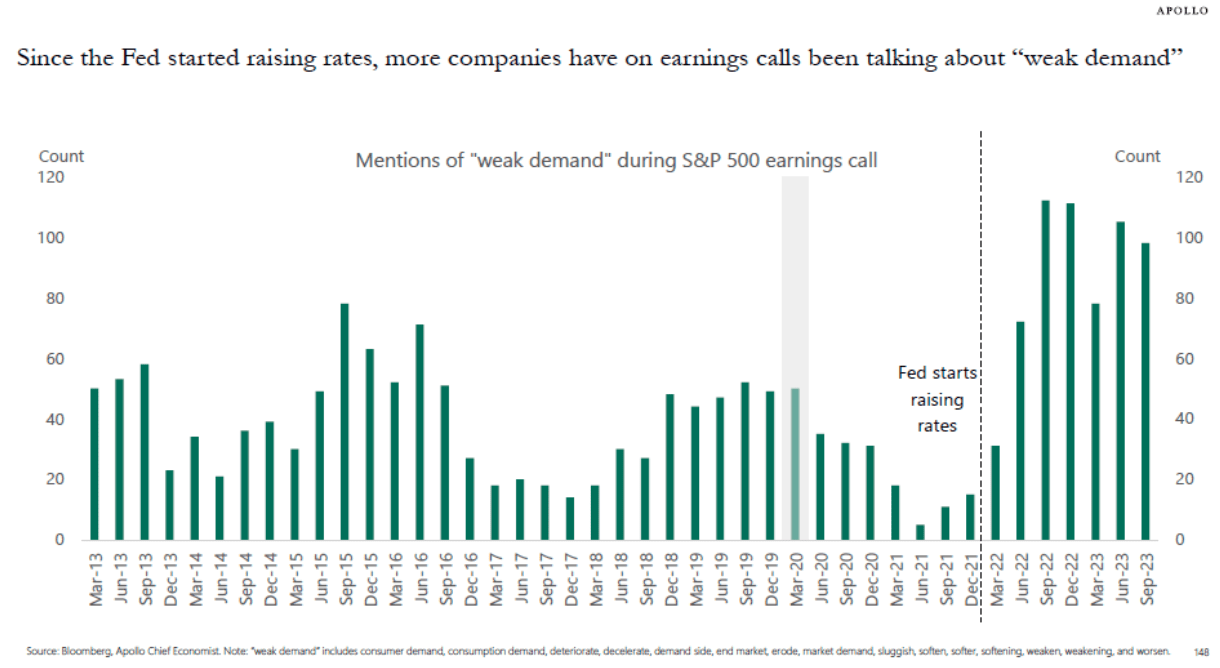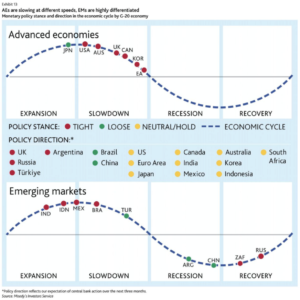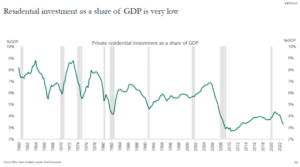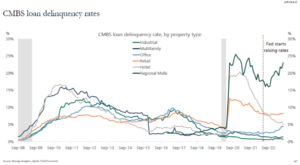
 Since the Fed started raising rates, and after the pandemic, more companies in the S&P 500 have been talking about “weak demand” on their earnings calls. In Chart 1 we see that in 4 of the last 5 quarters the number of mentions peaked at triple the rate of the previous year, between 100 and 120 while the previous decade shows a range of between 20 and 60 mentions. “Weak demand” is in the air. Is this a sign of a coming recession and what will this mean for housing prices?
Since the Fed started raising rates, and after the pandemic, more companies in the S&P 500 have been talking about “weak demand” on their earnings calls. In Chart 1 we see that in 4 of the last 5 quarters the number of mentions peaked at triple the rate of the previous year, between 100 and 120 while the previous decade shows a range of between 20 and 60 mentions. “Weak demand” is in the air. Is this a sign of a coming recession and what will this mean for housing prices?
I have written in previous columns about our national housing inventory problem. We are short at least 5 million houses and new supply is not on the horizon (in our area). Supply constraints will cause housing prices to rise both nationally and in our area. The greatest predictor of demand comes from demographic trends. Specifically, we cannot ignore the number of Millenials entering the housing market over the next 5 years and the kinds of houses they prefer. So then, are we heading into recession?
Chart 2 shows that Advanced economies are slowing at different speeds and the USA is only at the beginning of the “slowdown” phase with some time left before recession. That is reassuring. We know a “tight” policy stance heading to “neutral” and that has been reflected in 30 yr. mortgage rates which have fallen 4 weeks in a row to 7.25% this week since peaking on October 18 above 8%. (15-year mortgages are now in the 6’s) According to the Mortgage Bankers Association demand for mortgages increased 3% from last week while refinance application activity went up 2% but is down 4% from where it was a year ago.
Another place we can look for signs of a coming recession might be in loan delinquency rates. Chart 3 shows that Regional Malls are in trouble. That’s nothing new. What is interesting is that these classes of real estate have historically moved together. Since the pandemic and after the Fed started raising rates there has been a widening range between the different types of commercial real estate. Hotels are much healthier, down from a 20% default rate to only 5% and Retail defaults have dropped about 3 points from 11% to 8%. Work-from-home has everybody worried about the health of Office space but the level of defaults is still relatively low, moving from 3% to 4%.
Wall Street expects the Fed will cut rates several times in 2024 in order to approach “neutral”. UBS expects 2.75% in cuts. That’s 11 times at a quarter point each beginning in March 2024. Maquarie expects 2.25%; ING expects 1.50%; Barclays  expects 1.00%; Goldman Sachs expects only 2 cuts starting in Q3. Futures markets are currently pricing in cuts of 1.25% for a Fed Funds rate of 4.00% – 4.25%. This would result in fixed rate mortgages of around 6%. However, the Fed’s own projection is for only one cut of 25 basis points and that would probably result in mortgages in the high 6’s, not much different from today.
expects 1.00%; Goldman Sachs expects only 2 cuts starting in Q3. Futures markets are currently pricing in cuts of 1.25% for a Fed Funds rate of 4.00% – 4.25%. This would result in fixed rate mortgages of around 6%. However, the Fed’s own projection is for only one cut of 25 basis points and that would probably result in mortgages in the high 6’s, not much different from today.
Lawrence Yun, chief economist for NAR (National Association of Realtors) predicts mortgage rates between 6% and 7% beginning in the Spring based on those Fed cuts and a slowing economy. Since Wall Street and the Fed are both signaling for nothing to happen until at least the middle of the year this won’t benefit homebuyers and sellers in the Spring market, February through May. For mortgage rates to fall this Spring the jobs reports and inflation must show a rapidly weakening economy now. The graphs don’t show it and Wall Street doesn’t predict it. Most likely it will be 2025 before we see rates back in the 5’s.
So, when is the recession? The definition of recession is two down quarters and on the question of if and when the experts are split. As of late November the Fed was no longer forecasting a recession. GBillionaire Ken Griffin and the economists at UBS and Deutche Bank are setting the expectation for recession in Q2 or Q3 while economists from UCLA, Comerica Bank, the CEO of Bank of America and the Atlanta Fed President predict a soft landing, no recession in 2024. Those who predict recession are focused on the rise in deficit spending while those predicting a soft landing base their forecast on strong consumer finances and spending. Goldman Sachs put a number on it, predicting 15% chance we would enter a (mild) recession and that inflation will continue to fall in 2024.
What does this mean for the Spring real estate market in our area?
Not much change from the current situation, I’m afraid. Whether the sine wave on the accompanying graph is flatter (soft landing) or steeper (says UBS) we are mostly addressing questions of affordability and economic growth. They affect the  rates borrowers pay, and consequently their level of confidence in making offers, but they do not address the fundamental lack of supply that has been years in the making. What that sine wave looks like will likely have an impact on rates and the offers that buyers want to make. But, we cannot ignore demographics. Demand remains strong despite the risk of recession and there is a lagging effect where home prices will trail economic indicators. It will take several quarters of bad news before sellers accept that there has been a change. Come Spring there will still be too little inventory for too many buyers putting upward pressure on prices but those buyers have limits on what they can finance and what price appreciation they will accept. Prediction for the Spring market is interest rates around 7%, housing price appreciation around Fairfield County remains at 5%, and that speculative new home construction remain low until we emerge from slowdown/recession a few years from now.
rates borrowers pay, and consequently their level of confidence in making offers, but they do not address the fundamental lack of supply that has been years in the making. What that sine wave looks like will likely have an impact on rates and the offers that buyers want to make. But, we cannot ignore demographics. Demand remains strong despite the risk of recession and there is a lagging effect where home prices will trail economic indicators. It will take several quarters of bad news before sellers accept that there has been a change. Come Spring there will still be too little inventory for too many buyers putting upward pressure on prices but those buyers have limits on what they can finance and what price appreciation they will accept. Prediction for the Spring market is interest rates around 7%, housing price appreciation around Fairfield County remains at 5%, and that speculative new home construction remain low until we emerge from slowdown/recession a few years from now.
John Engel is a Realtor with the Engel Team at Douglas Elliman. The best economics class he ever had was with Mr. Larcom at New Canaan High School (1985) a computer simulation in which 80 students traded commodities: axes & shovels, iron & wood in a competition to study the effect of supply and demand on prices. (Incidentally, Scott Hobbs won the competition in spectacular fashion by employing billions in leverage to corner the market.) Just an example of how NCHS prepares students to succeed.


